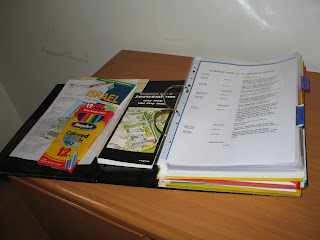Or in English: "An interesting Sabbath day in Jerusalem".
Israelis use greetings similar to us like "Good morning" (although they don't have a simple word for afternoon, so the afternoon greeting is quite long). You can also use "Shalom" (roughly "peace") as a greeting at any time of the day, or answering the phone, etc. However, from Friday afternoon onwards, you use the special Sabbath greeting "Shabbat shalom".
Shops start closing down by 3pm on Friday afternoon, and the Sabbath officially begins at sunset. A religious community in the next neighbourhood sing songs (amplified) just before sunset and then blow the shofar (ram's horn) so we heard that from the house. Public buses stop on the Sabbath, but you can still get taxis -- although they might ask a higher price since they know you have less choices for travel.

The family I am staying with would not call themselves very religious. However, they do have a special meal together on Friday evenings -- often the only meal they have together in the week. Donning a yarmulke, the father stood and read the blessing from a laminated sheet. Then a silver goblet of wine was passed around the table to drink from. Then he lifted a beautifully decorated special cloth from the basket of bread, broke off a piece, put some pepper on it and ate it. He then broke off a piece for everyone, peppered it, and passed it to us to eat. Then the special items were cleared away, the rest of the bread was sliced and put on the table, and the normal meal began.
This family does eat "kosher", which of course means no pork or shrimp, etc. It also means not mixing a meat meal with milk products (including cheese or mayonnaise containing milk). Also, Israelis don't seem to have milk in their coffee -- perhaps because they might have coffee after a meat meal??? Fish is not classified as meat, so it's okay to have a cheese sauce on your fish. Chicken is now classified as meat.
More religious Jews have many more regulations which they adhere to. For instance, you cannot light a fire on the Sabbath. So the candles are lit by the mother right at sunset before the Sabbath is announced. (We didn't have any candles in this household though.) In the modern culture, turning on something electric is regarded as using "fire". So if you want to use electric lights (including torches/flashlights), you also have to turn them on before the Sabbath begins. Of course you can't use the gas or electric stove on the Sabbath. Opening the fridge causes the light inside to come on, so if you want to use the fridge, you have to disable/remove the internal light before the Sabbath begins.
Walking by an automatic security light and causing it to come on (e.g., if you are coming home from the Friday night synagogue service) is breaking the Sabbath, although there are exceptions for accidentally failures. But the "kohen" Jew (i.e., of priestly/Aaronic heritage) who told me this, said that he has learnt where the automatic security lights are and crosses the street as he walks home from the synagogue to avoid setting them off.
But the family I am with here don't concern themselves with these things. In fact, they took me for a pleasant drive in the car on Saturday morning. They do attend synagogue, but mostly only on special holidays like at Passover or Yom Kippur.
So Jerusalem is mostly closed on Saturday -- all the way from the little dairy to the restaurants to the huge Jerusalem mall. However, if you would like to eat out, it's popular to go to some of the Arab neighbourhoods and get a nice meal there as their Friday holy day/holiday is already over. But apparently Tel Aviv is much more secular than Jerusalem and has much more open.
Then in Jerusalem, things start to open again after sunset on Saturday evening. In the summer like now, that's after 9pm, but much earlier in the winter. So the socialites go and eat out then or go to the mall to shop or socialize. So from 9:30 or so until midnight or so, Jerusalem comes alive again.
This family ordered pizza for dinner (which we started around 10pm). It's also kosher, so meatless since it has cheese, but tuna pizza is ok. We had it with wine -- they drink it quite a bit -- just a glass with the meal.
Then Sunday morning is busy traffic and everyone's back to school and work. It takes a little bit of getting used to when you've considered Sunday as a rest/church day all your life.




.JPG)













































.jpg)